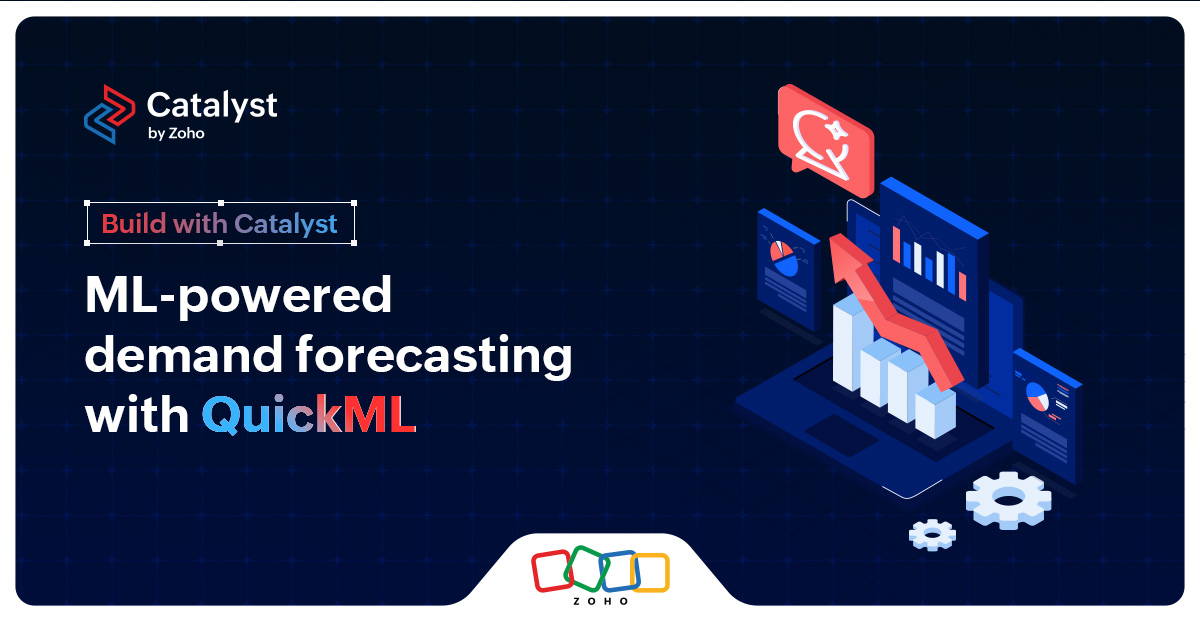- HOME
- Build with Catalyst: ML-powered demand forecasting with QuickML
Build with Catalyst: ML-powered demand forecasting with QuickML
- Last Updated : May 7, 2024
- 654 Views
- 4 Min Read

For our next use case in our Build with Catalyst series, we'll look at how you can build a prediction tool for sales forecasting and make informed decisions with QuickML's powerful machine-learning models.
Check out our previous posts in the series to learn how you can:
Now, let's get started!
What is Catalyst QuickML?
Catalyst QuickML is an end-to-end machine learning platform from Catalyst to build, train, and optimize ML models, facilitating data-driven decision-making. QuickML empowers developers—with or without ML expertise—to create powerful, custom ML models and harness the power of AI.
Build an ML-powered demand forecasting engine with QuickML
Before delving into the role of QuickML in demand forecasting, let's look at how sales and demand forecasting works, in general. Sales and demand forecasting involves predicting future sales volumes or revenues based on historical data, market trends, and various other factors. For example, if you run an e-commerce platform, knowing the number of orders or traffic your platform will get during the upcoming holiday season can help you ensure your staff is trained and equipped enough to handle it all. To do that, you want to gather sales and traffic data from previous years, data regarding current shopping trends, information on the economic state, buying habits, and more.
Traditional methods often rely on manual analysis and statistical techniques, which can be time-consuming and prone to errors. Machine learning algorithms offer a more sophisticated approach to sales forecasting by automatically identifying patterns and relationships within vast datasets. These algorithms can adapt and improve over time, providing more accurate predictions as they learn from new data.
Let's look at the broader steps involved in a sales forecasting process with a practical example.
Say a retail company wants to forecast its sales for the upcoming quarter to optimize inventory management and marketing strategies. They would have to go through the following process.
Data collection
The company gathers historical sales data, including past revenues, seasonal fluctuations, marketing campaigns, and economic indicators.
Data preprocessing
Using QuickML, the data is preprocessed to handle missing values, normalize features, and encode categorical variables.
Model training
You can select the most suitable machine learning algorithms and hyper-parameters based on the data characteristics. You can experiment with multiple models, such as linear regression, decision trees, and ensemble methods to find the best-performing model.
Evaluation and deployment
The trained model is evaluated using performance metrics like Mean Absolute Error (MAE) or Root Mean Squared Error (RMSE). Once validated, the model is deployed to generate real-time sales forecasts for the upcoming quarter.
Continuous improvement
As new sales data becomes available, the model can be retrained periodically to incorporate the latest information and improve forecasting accuracy over time.
Catalyst components needed to achieve this:
To create a high-quality ML model in QuickML that can give solid predictions, follow these steps:
Feed the historical data to Catalyst QuickML. This includes historical sales data, including past revenues, seasonal fluctuations, marketing campaigns, economic indicators, and more. QuickML can help collate this data coming from different sources and as separate files into one.
Build a pipeline to produce a model that identifies trends based on demand and sales data. Once models are created, QuickML can figure out the data points and factors that can point to potential demand for the required timeline.
Establish an endpoint using QuickML when the model is ready. This endpoint will provide a REST API to share prediction information to the desired management tool.
Query the created model each season with recent sales and demand data to ensure it adapts to changes in new usage patterns.
Use Catalyst Functions to push predictions back to your management tool. This could help you filter the data accordingly to ensure you are stocked up and that the staff is informed.
Since you could also figure out what factor or price point is the key, you could ensure you put out attractive offers to seal the deal with your customers.
You can follow a similar workflow for multiple use cases. Get creative, tap into your data goldmine, and make informed business decisions.
We'd love to hear about your journey with Catalyst QuickML. Feel free to share your thoughts in the comments section or get a detailed one-on-one session. We will come back next week with another compelling use case. Stay tuned to this space to see how you can take full advantage of Catalyst and its capabilities.